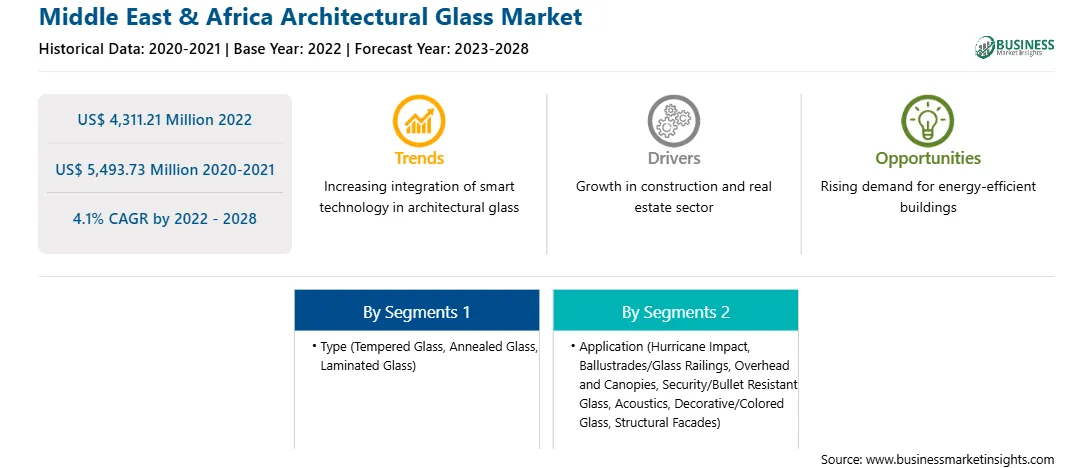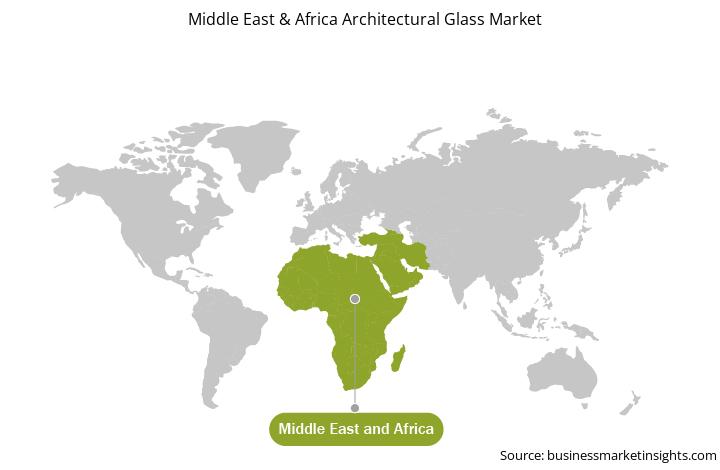Growing Demand for Colored and Printed Glass will be Driving in The Middle East & Africa Architectural Glass Market in Upcoming Years
With growing economy and increasing living standards and modernization among the population globally, the use of decorative glass, such as printed and colored glass, in designing the interiors of residential and commercial buildings is increasing. The demand for screen printing glass in the construction industry is growing as it offers various aesthetic advantages over traditional building materials. Screen printing glass expands its uses in industrial, commercial, and architectural applications such as display windows, building exterior landscaping, architectural space partitions, mosaic glass, furniture decoration, and other 3D objects. Such advancement in glass manufacturing varieties is further expected to boost the demand for architectural glass. Moreover, digital printing is a trending technology used to decorate architectural glass. Manufacturers are incorporating this technology into their products to cater to consumers’ growing demand. For instance, in September 2021, Marabu and Koenig & Bauer partnered to launch a digital printing solution for glass. They create a solution that offers glass product manufacturers an alternative to traditional embossing techniques. Such technological investment by manufacturers to develop colored and printed glass is further expected to bring new trends to the Middle East & Africa architectural glass market during the forecast period.
Middle East & Africa Architectural Glass Market Overview
The Middle East & Africa architectural glass market is segmented into South Africa, Saudi Arabia, the UAE, and the Rest of the Middle East & Africa. Countries in the Middle East & Africa are rapidly developing their public infrastructure, including airports, hospitals, and administrative buildings. This has resulted in the spurred demand for architectural glass as the choice of construction material for various applications, namely, facades, windows and other exterior as well as interior applications. Furthermore, a surge in demand for interior and exterior glass glazing in residential buildings, coupled with rapid urbanization in the region, has enhanced construction activities, which is expected to support the Middle East & Africa architectural glass market during the forecast period. The construction of shopping malls and commercial complexes has increased due to the rising tourism industry and the growing number of immigrants. Therefore, the utilization of volumes of architectural glass in the construction of commercial buildings is expected to provide significant growth opportunities to the market players. Further, the rising inclination toward renewable energy sources and the adoption of solar power is boosting the demand for architectural laminated glass in the Middle East & Africa. Moreover, the main trends in the Middle East architectural glass market are the development and installation of smart solutions such as dynamic smart glass. The application of dynamic glass addresses three important requirements of the construction & real estate industry in the region, including a reduction in energy consumption and maximum energy conservation, enhanced human experience, and occupant comfort. Therefore, these factors are anticipated to boost the Middle East & Africa architectural glass market in the coming years.

Strategic insights for the Middle East & Africa Architectural Glass provides data-driven analysis of the industry landscape, including current trends, key players, and regional nuances. These insights offer actionable recommendations, enabling readers to differentiate themselves from competitors by identifying untapped segments or developing unique value propositions. Leveraging data analytics, these insights help industry players anticipate the market shifts, whether investors, manufacturers, or other stakeholders. A future-oriented perspective is essential, helping stakeholders anticipate market shifts and position themselves for long-term success in this dynamic region. Ultimately, effective strategic insights empower readers to make informed decisions that drive profitability and achieve their business objectives within the market.

| Report Attribute | Details |
|---|---|
| Market size in 2022 | US$ 4,311.21 Million |
| Market Size by 2028 | US$ 5,493.73 Million |
| Global CAGR (2022 - 2028) | 4.1% |
| Historical Data | 2020-2021 |
| Forecast period | 2023-2028 |
| Segments Covered |
By Type
|
| Regions and Countries Covered | Middle East and Africa
|
| Market leaders and key company profiles |
The geographic scope of the Middle East & Africa Architectural Glass refers to the specific areas in which a business operates and competes. Understanding local distinctions, such as diverse consumer preferences (e.g., demand for specific plug types or battery backup durations), varying economic conditions, and regulatory environments, is crucial for tailoring strategies to specific markets. Businesses can expand their reach by identifying underserved areas or adapting their offerings to meet local demands. A clear market focus allows for more effective resource allocation, targeted marketing campaigns, and better positioning against local competitors, ultimately driving growth in those targeted areas.

Middle East & Africa Architectural Glass Market Segmentation
The Middle East & Africa architectural glass market is segmented into type, application, and country.
Based on type, the Middle East & Africa architectural glass market is segmented into tempered glass, annealed glass, laminated glass, and others. In 2022, the laminated glass segment registered a largest share in the Middle East & Africa architectural glass market.
Based on application, the Middle East & Africa architectural glass market is segmented into hurricane impact, ballustrades/glass railings, overhead and canopies, security/bullet resistant glass, acoustics, decorative/colored glass, structural facades, and others. In 2022, the structural facades segment registered a largest share in the Middle East & Africa architectural glass market.
Based on country, the Middle East & Africa architectural glass market is segmented into South Africa, Saudi Arabia, the UAE, and the Rest of Middle East & Africa. In 2022, the Rest of Middle East & Africa segment registered a largest share in the Middle East & Africa architectural glass market.
AGC Inc; Asahi India Glass Ltd; Compagnie de Saint-Gobain SA; Guardian Industries Holdings LLC; Nippon Sheet Glass Co Ltd; Schott AG; Turkiye Sise ve Cam Fabrikalari AS; and Jinjing (Group) Co Ltd are the leading companies operating in the Middle East & Africa architectural glass market.
The Middle East & Africa Architectural Glass Market is valued at US$ 4,311.21 Million in 2022, it is projected to reach US$ 5,493.73 Million by 2028.
As per our report Middle East & Africa Architectural Glass Market, the market size is valued at US$ 4,311.21 Million in 2022, projecting it to reach US$ 5,493.73 Million by 2028. This translates to a CAGR of approximately 4.1% during the forecast period.
The Middle East & Africa Architectural Glass Market report typically cover these key segments-
The historic period, base year, and forecast period can vary slightly depending on the specific market research report. However, for the Middle East & Africa Architectural Glass Market report:
The Middle East & Africa Architectural Glass Market is populated by several key players, each contributing to its growth and innovation. Some of the major players include:
The Middle East & Africa Architectural Glass Market report is valuable for diverse stakeholders, including:
Essentially, anyone involved in or considering involvement in the Middle East & Africa Architectural Glass Market value chain can benefit from the information contained in a comprehensive market report.